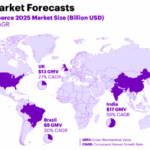In the 2023/2024 financial year, Europe’s cross-border ecommerce market achieved remarkable growth, reaching a total of 326 billion euros in sales. A significant portion of this, 69 percent (or 225 billion euros), was driven by online marketplaces. These findings come from the latest edition of the “Top 100 Cross-Border Marketplaces Europe” report by Cross-Border Commerce Europe, which provides a detailed analysis of the key players and trends shaping the cross-border ecommerce landscape in Europe.
Marketplaces Leading the Way
Online marketplaces continue to be the dominant force in cross-border ecommerce across Europe. According to the report, the top 10 marketplaces generated more than half of the total marketplace-driven turnover. These platforms, including well-known names like Amazon and eBay, have become essential for European consumers looking for a wide range of products from international sellers. For businesses, these marketplaces offer an easy way to expand beyond domestic markets and reach a broader audience without the complexities of managing cross-border logistics and sales channels on their own.
The complete top 100 marketplaces accounted for a combined turnover of 197.01 billion euros in 2023, reflecting an impressive 39.29 percent growth compared to the previous year. This surge highlights the increasing reliance on marketplaces by both consumers and businesses for cross-border transactions.
Growth in European Cross-Border Ecommerce
The broader European cross-border ecommerce market has experienced substantial growth as well. Earlier this year, Cross-Border Commerce Europe published a report indicating that the cross-border ecommerce market in 2023 saw a 32 percent increase compared to 2022. This growth resulted in European online stores generating 107 billion euros in cross-border sales.
The rise of cross-border ecommerce can be attributed to several factors, including the growing popularity of online shopping, improved logistics and delivery services, and the ease of accessing global products through online platforms. Consumers are increasingly comfortable purchasing products from foreign sellers, thanks to advancements in payment security and shipping options, which have removed many of the traditional barriers to international trade.
Marketplaces Share to Decline Slightly by 2025
Despite the current dominance of marketplaces, researchers predict a slight decline in their share of total ecommerce gross merchandise value (GMV) over the next few years. By 2025, the share of cross-border sales attributed to marketplaces is expected to drop from 69 percent to 67.9 percent. This anticipated decline may indicate the beginning of market maturation as more European online retailers establish their own cross-border sales channels and reduce their dependence on third-party marketplaces.
This shift could also be driven by businesses seeking more control over their customer relationships, brand presentation, and profit margins by handling their own cross-border sales operations rather than relying on marketplace platforms.










